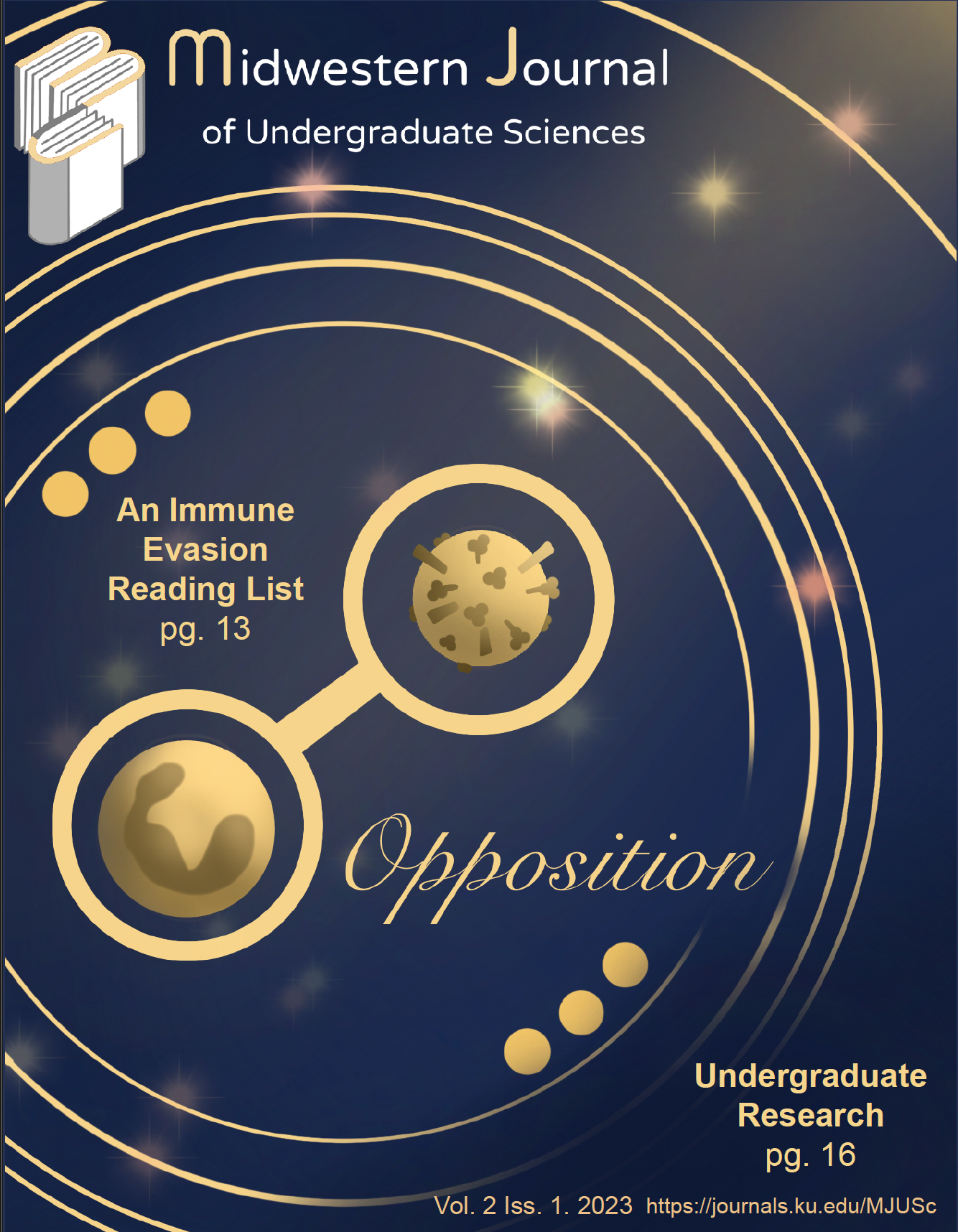Beware the HIV Env, Which Comes to you in Glycosylated Coating
DOI:
https://doi.org/10.17161/mjusc.v2i1.21710Keywords:
HCMV, Glycosylation, HIV, gp120Abstract
Excess cellular radical oxygen species are associated with an increase in cellular, including genetic
damage. In somatic cells, this may lead to cancer when genes associated with cell growth
and reproduction are impacted. Opposing radical oxygen species are antioxidants which can
quench free radicals that otherwise may damage a cell’s DNA. The body produces some antioxidants
naturally, such as glutathione, while others are obtained through diet, including vitamins
C and E. Chlorogenic Acid (CGA) is one example of a polyphenolic compound in coffee
with the potential to exhibit antioxidant and antimutagenic properties. The concentration of
CGA in a commercially available coffee was measured and its potential to exhibit antioxidant
properties was assessed. An extract was prepared in which the spectral properties of CGA
were exploited to quantitate its concentration in green coffee extract via HPLC. The antioxidant
activity of CGA was characterized by measuring its relative ability to neutralize free radicals using
a colorimetric assay vs. a pure vitamin C standard. The antimutagenic activity of CGA was
to be assessed via an Ames test using mutant Salmonella strains incapable of producing the
amino acid histidine. The results demonstrated a considerable amount of CGA in green coffee
extract, that exhibited antioxidant properties. Future work will assess antimutagenic effects
of CGA in the extract compared to the antimutagenic effect of vitamin C and pure CGA standards.
Overall, these results suggested that coffee beverages may serve as potent antioxidants
with the potential to protect consumers from the harmful effects of mutagenic free radicals.
References
Coffee. Wikipedia (2023).
Ayelign, A. & Sabally, K. Determination of Chlorogenic Acids (CGA) in Coffee Beans using HPLC. 1, 14.
Method for extracting chlorogenic acid from green coffee beans. (2015).
https://www.facebook.com/verywell. What Are Polyphenols? Verywell Health https://www.verywellhealth.com/polyphenols-
Reactive oxygen species. Wikipedia (2023).
Hutachok, N. et al. Chemical Analysis, Toxicity Study, and Free-Radical Scavenging and Iron-Binding Assays Involving Coffee (Coffea arabica) Extracts. Molecules 26, 4169 (2021).
Antioxidants and Cancer Prevention -NCI. https://www.cancer.gov/about-cancer/causes-prevention/risk/diet/antioxidants-fact-sheet (2014).
Farah, A. & Donangelo, C. Phenolic compounds in coffee. Braz. Brazilian Journal of Plant Physiology 18, (2006).
Zeng, A. et al. Chlorogenic acid induces apoptosis, inhibits metastasis and improves antitumor immunity in breast cancer via the NF‑κB signaling pathway. Oncology Reports 45, 717–727 (2021).
Chlorogenic acid. Wikipedia (2022).
Nehlig, A. & Debry, G. Potential genotoxic, mutagenic and antimutagenic effects of coffee: a review. Mutat Res 317, 145–162 (1994).
Hayakawa, S. et al. Anti-Cancer Effects of Green Tea Epigallocatchin-3-Gallate and Coffee Chlorogenic Acid. Molecules 25, 4553 (2020).
Wierzejska, R. Coffee consumption vs. cancer risk - a review of scientific data. Rocz Panstw Zakl Hig 66, 293–298 (2015).
Pauwels, E. K. J. & Volterrani, D. Coffee Consumption and Cancer Risk: An Assessment of the Health Implications Based on Recent Knowledge. Med Princ Pract 30, 401–411 (2021).
Vijay, U., Gupta, S., Mathur, P., Suravajhala, P. & Bhatnagar, P. Microbial Mutagenicity Assay: Ames Test. Bio-protocol 8, e2763–e2763 (2018).
Pagnout, C. et al. Pleiotropic effects of gene mutations on Escherichia coli envelope properties. Sci Rep 9, 9696 (2019).
Maron, D. M. & Ames, B. N. Revised methods for the Salmonella mutagenicity test. Mutat Res 113, 173–215 (1983).
Maracaturra Coffee - Large Coffee Beans With a Full Body. BrewLogy https://brewlogy.com/beans/maracaturra/.
Awwad, S., Issa, R., Alnsour, L., Albals, D. & Al-Momani, I. Quantification of Caffeine and Chlorogenic Acid in Green and Roasted Coffee Samples Using HPLC-DAD and Evaluation of the Effect of Degree of Roasting on Their Levels. Molecules 26, 7502 (2021).
Moreira, D. C. ABTS decolorization assay –in vitro antioxidant capacity. (2019).
Thongsuk, P. & Sameenoi, Y. Colorimetric determination of radical scavenging activity of antioxidants using Fe3O4 magnetic nanoparticles. Arabian Journal of Chemistry 15, 103475 (2022).
Tang, W. et al. Phenolic Compounds Profile and Antioxidant Capacity of Pitahaya Fruit Peel from Two Red-Skinned Species (Hylocereus polyrhizus and Hylocereus undatus). Foods 10, 1183 (2021).
Downloads
Published
Issue
Section
License
Copyright (c) 2024 Abreen Niaman

This work is licensed under a Creative Commons Attribution-NonCommercial 4.0 International License.
© The Author(s)
This work is licensed under a Creative Commons Attribution-NonCommercial 4.0 International license.

